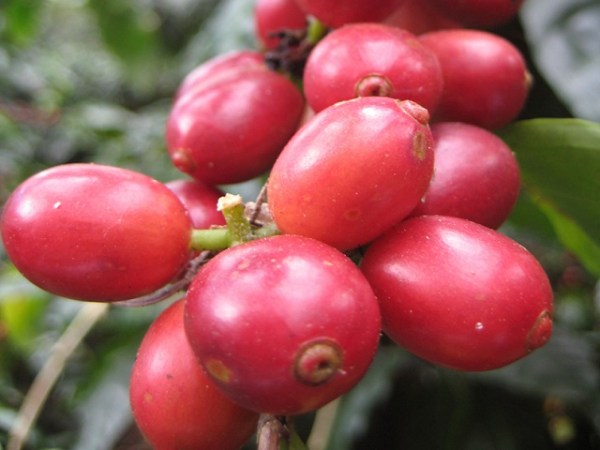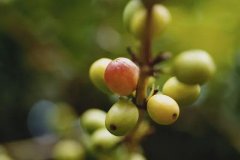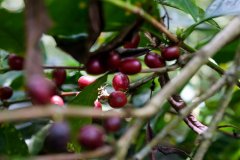What is the difference between Starbucks coffee beans and KFC Arabica coffee beans?

Professional coffee knowledge exchange more coffee bean information please follow the coffee workshop (Wechat official account cafe_style)
Arabica
There was a shepherd in Ethiopia in the 16th century. One day he found his sheep jumping up and down there, and he thought it was amazing.
After careful observation, we realized that it was because the sheep had eaten a kind of red fruit.
Under the publicity of the shepherd boy, more and more people learned about the refreshing effect of the fruit, and all felt refreshed after eating it.
Later, the fruit became a refreshing drug used in long religious rituals.
It, it's coffee...
The seeds hidden in this fruit are coffee beans.
That is, the coffee (cooked) beans / powder bought on the market, instant coffee and other raw materials are roasted and made.
Varieties of coffee sold on the market.
Coffee beans are divided into three original species systems.
Arabica coffee beans, also known as Arabica coffee beans
Robusta coffee beans, also known as Congo coffee beans.
Libyan coffee beans, also known as Liberian coffee beans
There are more than 100 kinds of coffee in the world today.
Common cultivated species, multi-genus, three original species system and some hybrids
The three original species can be subdivided into dozens of varieties.
Therefore, coffee beans will have different characteristics according to different varieties, producing areas and brands.
Arabica coffee beans account for 76% of the world's total output.
Robusta coffee beans, accounting for about 20% of the world's total output.
Liberian coffee beans are consumed only by people in Europe, except in a few producing countries.
Arabica coffee was first introduced in Taiwan. At present, Arabica coffee is also cultivated in a large area.
Arabica (Arabica):
The planting cost is high, the quality is good, the taste is particularly mellow, growing in high altitude areas, including Nicaragua, Costa Rica, Panama and other Latin American countries specialize in growing this variety of coffee. Native to the Abyssinia Plateau in southern Ethiopia, East Africa, there are still wild species along the coast.
Arabica coffee has the best flavor, good flavor, balanced taste, the best quality and the highest market price in each system. Distributed in Africa, Indonesia, Central and South America and other regions.
Arabica coffee was first introduced in Taiwan, and Arabica coffee is also the most widely grown at present.
At present, the varieties cultivated in Brazil are Typical, Bourbon, Mound Novo, Caturra and so on.
This variety is an evergreen shrub with a height of up to 3 ∼ 7 meters and a grayish yellow-brown bark with shallow longitudinal cracks.
The leaf is simple opposite, the leaf blade is long elliptic or ovate-elliptic, the leaf tip is sharp, the leaf margin is entire with microwave, the leaf length is 10 ∼ 20 cm, the leaf width is 4 ∼ 8 cm.
Flowers 10 ∼ 20 clustered in the axils of lateral branches and leaves, flowers small in diameter of about 3 cm, Corolla white, flowering will give off a unique pleasant fragrance.
The fruit is an oval drupe, the immature fruit is dark green, the fruit surface is dark red or yellowish red when ripe, 1.2cm ∼ 1.5cm long, each fruit weighs 1.0∼ 2.5g, the fruit is formed by exocarp, pulp, endocarp, seeds (coffee beans), the pulp is thin yellowish white, rich in moisture, slightly sweet, containing two seeds, with a light yellow seed shell, which is easy to separate after drying.
Picture
Arabica flower
Robusta (Chinese translation: Robusta)
Robusta coffee is a mutant of Congo coffee, originated in West Africa, Congo, this species has the regret of lack of aroma, strong bitterness and lack of sour taste.
This variety has a large plant, up to 5 ∼ 8 meters high, with an umbrella-shaped crown, long and drooping branches, strong growth and a tree posture slightly similar to Arabica coffee.
The leaf is single leaf opposite, the leaf is larger than Arabica coffee, the leaf is entire, has shallow wave shape concave and convex, is a major characteristic.
The flower cluster grows in the leaf axil, one branch often has a hundred flowers, the flower fragrance is strong.
The fruit is a round or flat drupe, the unripe fruit is dark green, the fruit surface is dark red when ripe, and grows smaller than Libyan coffee in lower and hot areas.
Low-cost brand coffee usually uses all or most of this level of coffee beans; Arabica & Robusta carve up almost 100% of the market.
Picture
Robusta flower
Liberica (Liberia):
Originated in Libya, West Africa, this kind of flavor is not good, bitter taste is strong. With the exception of a few producing countries that consume themselves, only Europeans drink Liberian coffee.
The plant of this variety is an evergreen shrub with a height of 10 ∼ 15 meters. The tree is strong, with luxuriant branches and leaves, erect branches, light ochre on the surface, and then grayish brown, twigs green, all smooth.
The leaf is large, with a length of 16 ∼ 35 cm and a width of 6 ∼ 18 cm. The whole margin of the leaf is long oval.
The flower is the largest flower in the genus Coffea. it is often densely clustered in the axils of the leaves and has a strong aroma when it blossoms. pure white and reddish flowers are common on the same fruiting branch, showing pure white or pink to crimson.
The fruit of this species is larger than Arabica coffee, with oval or subglobular shape, dark red pericarp, less pulp, sweet and bitter, with 3 seeds of 2 ∼, oval or oval in shape, immature green fruit and ripe red fruit at the same time.
The quality of "Liberia" is worse than that of "Robusta", and its output is relatively small, so it is almost impossible to buy "Liberian" coffee on the market, usually only in the laboratory.
Compared with the other two varieties, the taste of coffee is even more complex and exciting, coupled with the fact that the fresh beans of coffee are mainly dried (Dry Process).
Click here to edit.
Picture
Liberian flower
Subclassification of Arabica varieties.
In the world of "boutique coffee", only delicious Arabica varieties are classified and discussed.
The more representative varieties are:
Ancient native species: Heirloom (ancestral superior variety), Typica (Tibica), Bourbon (bourbon)
Typica variants: Maragogype (Giant Elephant Bean), Geisha (nicknamed geisha bean … Because of the homonym with [geisha], etc.
Well-known Bourbon variants: Caturra (Kaddura), Pacas (Pacas), etc.
Well-known hybrids: for example, Pacamara (Pacas + Giant Elephant Bean = Pacamara)
Characteristics of Arabica coffee beans-Why only Arabica is often used to make boutique coffee?
Important Notice :
前街咖啡 FrontStreet Coffee has moved to new addredd:
FrontStreet Coffee Address: 315,Donghua East Road,GuangZhou
Tel:020 38364473
- Prev

Coffee is divided into three original systems. What coffee beans do Starbucks use? Arabic coffee?
Arabica coffee began to be used by Yemenis in southwestern Arabia as early as 575 AD, Western Europe began to drink it around 1615, and coffee was popular in Europe in the early 17th century. Coffee in the world is mainly grown in America, Africa and Asia.
- Next

Which country is Arabica? The birthplace of Arabica coffee-Ethiopia Ethiopia!
Professional coffee knowledge exchange more coffee bean information please follow coffee workshop (Wechat official account cafe_style) Arabica wants to know coffee and its cultural story, you have to know the hometown of individual coffee Arabica (Arabica) coffee beans-Ethiopia, in addition to bringing you carefully selected Ethiopia-Yega Sheffield G1 coffee beans and linked
Related
- Detailed explanation of Jadeite planting Land in Panamanian Jadeite Manor introduction to the grading system of Jadeite competitive bidding, Red bid, Green bid and Rose Summer
- Story of Coffee planting in Brenka region of Costa Rica Stonehenge Manor anaerobic heavy honey treatment of flavor mouth
- What's on the barrel of Blue Mountain Coffee beans?
- Can American coffee also pull flowers? How to use hot American style to pull out a good-looking pattern?
- Can you make a cold extract with coffee beans? What is the right proportion for cold-extracted coffee formula?
- Indonesian PWN Gold Mandrine Coffee Origin Features Flavor How to Chong? Mandolin coffee is American.
- A brief introduction to the flavor characteristics of Brazilian yellow bourbon coffee beans
- What is the effect of different water quality on the flavor of cold-extracted coffee? What kind of water is best for brewing coffee?
- Why do you think of Rose Summer whenever you mention Panamanian coffee?
- Introduction to the characteristics of authentic blue mountain coffee bean producing areas? What is the CIB Coffee Authority in Jamaica?

